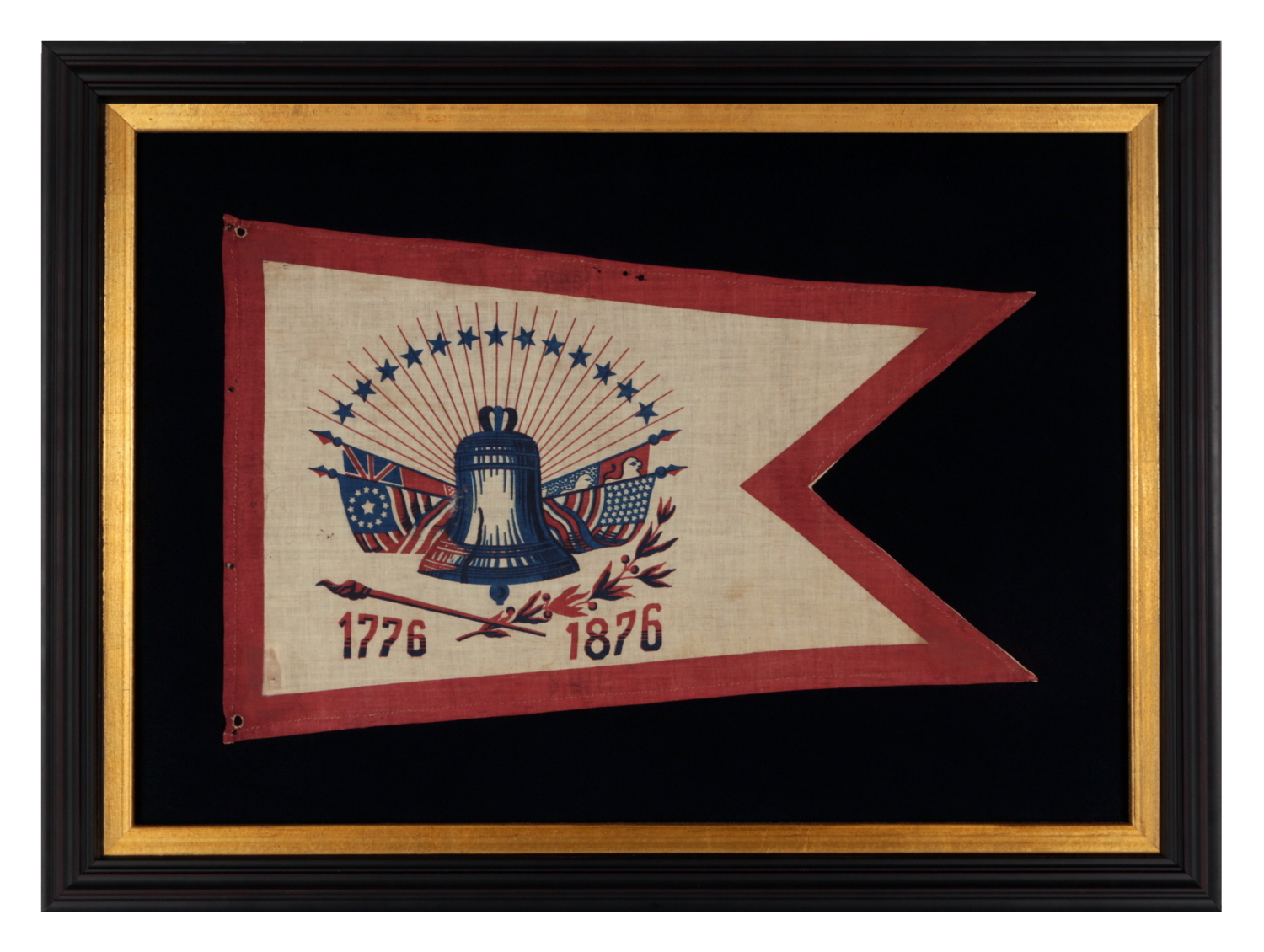


| SWALLOW-TAILED PARADE FLAG PENNANT / BANNER WITH AN IMAGE OF THE LIBERTY BELL BEFORE A FANNED ARRAY OF FLAGS & 13 STARS, MADE TO CELEBRATE THE 1876 CENTENNIAL OF AMERICAN INDEPENDENCE, UNIQUE AMONG KNOWN EXAMPLES |
|
| Web ID: | pat-831 |
| Available: | In Stock |
| Frame Size (H x L): | 20.5" x 28" |
| Flag Size (H x L): | 9.75" x 12.75" |
| Description: | |
| Early American parade flag pennant / banner, printed on cotton, with a tapered, swallow tail format and a scarlet red border. In the center, block-printed in red and blue, is an image of the Liberty Bell, flanked and crowned by a beautiful, patriotic display of flags and 13 stars, interspersed with rays of the rising sun. Cradling the device are the torch of Liberty and what is either an olive branch of peace or laurel for victory and honor. Below, respectively smaller, then larger, are the dates “1776” and “1876”, to honor the national anniversary. Note how the flags in the background are of those of Britain—a Red Ensign and a banner with Lions of the monarchy--while those in the foreground are American. To the proper right of the bell is a 13 star American national flag, with its stars arranged in what is known as the 3rd Maryland pattern, to represent the original colonies, and a 37 star flag, to represented the present count, official from July 4th, 1867 – July 3rd, 1877. Though most examples of the Stars & Stripes displayed at the centennial displayed 38 stars, to welcome Colorado, which joined the Union on August 1st, 1876, or 39 stars, in anticipation that the Dakota Territory would also soon enter (as a single state), many patriotic objects, probably designed as much as a year prior, or even more, incorporated 37. Numerous styles of parade flag pennants were produced for the centennial celebration. Though I have been buying, collecting, selling, and observing them for decades, I have not before encountered this colorful variation. The election to show the Liberty Bell is notable in 1876 specifically, when this icon of American freedom was brought for the from Independence Hall. First cracked during its initial testing in 1752, with its larger and most famous, irreparable crack suffered sometime during the early 1840’s, it had been displayed on the hall’s second floor for about a quarter century. In conjunction with its removal, the much larger “Centennial Bell,” made in part from four cannons, one American and one British, from the Revolutionary War Battle of Saratoga, plus one Union and one Confederate, from the Civil War Battle of Gettysburg, was installed that year in the tower of Independence Hall, to ring in the July 4th holiday that year. Made to be tacked to a staff, to be waved or otherwise displayed at parades or political events, this basic type of parade flag-type textile is known to have been produced by numerous makers. Designed in various forms, some horizontal and some vertical, those made for the centennial specifically are very scarce. Most are so rare that they survive as either one-of-one or one-of-two or three among known examples. Similar designs were available from various flag-makers throughout the latter 19th century and the beginning of the 20th, who readily copied one-another to compete for the same clientele of political, fraternal, and veteran’s organizations, World’s Fairs, and all manner of patriotic events. Some had rectangular profiles, some had straight sides with swallowtails, some were tapered and swallowtailed, like this example. Others were triangular. They were usually available with an array of standardized imagery. In addition to dates, anniversaries, events, and holidays, they included presidential portraits, generals, names of fraternal groups and organizations, fire companies, Civil War corps badges, and a myriad of state seals. Templates with starred borders could be special-ordered with whatever one desired. One of the most notable and endearing traits of this particular pennant can be found in the four, carefully, hand-sewn, whip-stitched grommets along the hoist. Though initially affixed by metal tacks, a former owner evidently felt it deserved greater care and attention, through more appropriate and elegant means of display. Mounting: For 25 years we have maintained our own textile conservation department, led by expert staff. We take great care in the mounting and preservation of flags and related textiles and have preserved thousands of examples. The two-part frame consists of a shadowbox style molding with a step-down profile and a surface that is very dark brown—almost black—with reddish undertones and highlights, to which a black-painted, hand-gilded and distressed, Italian molding, was added as a liner. The background is 100% cotton twill, black in color, that has been washed and treated for colorfastness. Spacers keep the textile away from the glazing, which is U.V. protective glass. Condition: There is extremely minor soiling, in addition of a number of modest to moderate instances of the same along the perimeter, in both the red and white regions of the fabric. A combination of both professional cleaning and color restoration was employed—the latter by way of a reversible medium, to restore its presentation. Many of my clients prefer early flags to show their age and history of use. |
|
| Video: | |
| Collector Level: | Advanced Collectors and the Person with Everything |
| Flag Type: | Parade flag |
| Star Count: | 13 |
| Earliest Date of Origin: | 1876 |
| Latest Date of Origin: | 1876 |
| State/Affiliation: | Pennsylvania |
| War Association: | |
| Price: | Please call (717) 676-0545 or (717) 502-1281 |
| E-mail: | info@jeffbridgman.com |
 |
|